Roman
Theater
The
Roman theater includes a) native / indigenous theatrical events, b)
events that
were created under the influence of Etruscan civilization (Etruria =
Tyrrinia, a region
in central
Italy
which developed
culture from the 8th century. BC), c) popular entertainment and d) artistic
forms of
theater.
A) native
theatrical events
- Feskennina mockery (versus
fescenini: either from
the
town Fescennium of
Etruria, or the fascium, the phallus
which the people of the town kept at
their parades, and could be
compared with the Greek satirical and phallic songs): Mocking
improvisational
types of songs whose
lyrics were obscene dialogues accompanied with theatrical gestures and they scoffed
strongly acts of aristocrats. They
were presented by
liberal, young Romans, not professionals, so-called istrios
(histriones, from Etruscan hister meant dancer)
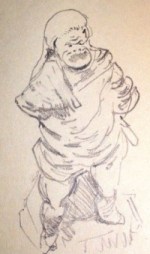 who came to mean a
hypocrite - actror, who danced
and sang to the accompaniment of flute.
who came to mean a
hypocrite - actror, who danced
and sang to the accompaniment of flute.
- Satura
(= variety, patchwork):
improvisational (initially) interactive songs accompanied by music and
dancing and portrayed with dance moves, a combination of feskenninon
scoff and Etruscan sign dance. From
the satura came later satire. It was developed
in the late 4 th century. BC
for about a hundred years. Its issues
of concern were
death, love, human weaknesses and faults, the prose descriptions of
everyday life. The actors were called planipedes (= gymnopodes, barefoot)
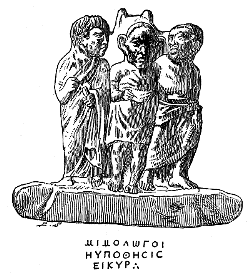 either because they did
not wear shoes or
because they were playing at a
flat orchestra. They
were playing without mask, and they were painting
their faces with chalk and psimythio, an innovative
action at that time
when no hypocrite does not appeared
in the Greek theater without mask.
either because they did
not wear shoes or
because they were playing at a
flat orchestra. They
were playing without mask, and they were painting
their faces with chalk and psimythio, an innovative
action at that time
when no hypocrite does not appeared
in the Greek theater without mask.
- Atellani
comedy or farce
(fabula atellana, the city Atella in Southern
Italy):
improvisational (initially) mockery in
daring and vulgar
sung lyrics, which were mutually
exchanged between the residents of the province during rural festivals.
Later, when they began to acquire some more structured plot, they were
played in honor of the dead.
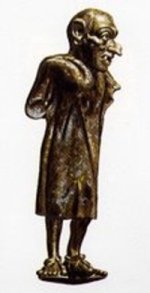
It
is the first theatrical spectacle brought to Rome towards the end of
the 4th century
BC.
In atellani comedy actors were ordinary citizens rather than
professionals who
came
out shamelessly and wore
half masks in the upper half of the face. In time firm types were crystallized
such as Pantalon (maccus)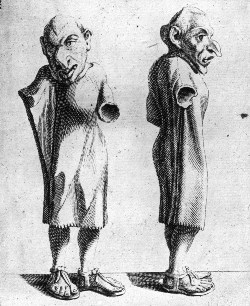 , the old man
(pappus)
, the old man
(pappus)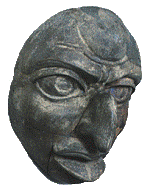 , the eater (bucco)
, the eater (bucco) ,
the hunchback scholar (dossenus)
,
the hunchback scholar (dossenus) . The characters that atellani
theater created remained for many centuries as "theater types" in
makeshift outdoor theater and passing through the wooden scenes of
medieval fairgrounds, these types will
be the backbone of the characters of the Renaissance comedia dell 'arte
. The characters that atellani
theater created remained for many centuries as "theater types" in
makeshift outdoor theater and passing through the wooden scenes of
medieval fairgrounds, these types will
be the backbone of the characters of the Renaissance comedia dell 'arte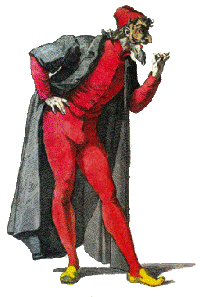 . The themes of atellani
comedies revolved mainly around the mores of
farmers of Campania, and around the popular professions such as' the
barber of the village, the "fishermen" and the mockery of
the manners and customs of other people. The mockingly vulgar
expressions of atellani
dramas began to be played
as epilogues
at the end of the performances of tragedies so that the
the public went
lightly on emotions (the same role is played by the satirical drama at
the end of the Greek tragic events).
. The themes of atellani
comedies revolved mainly around the mores of
farmers of Campania, and around the popular professions such as' the
barber of the village, the "fishermen" and the mockery of
the manners and customs of other people. The mockingly vulgar
expressions of atellani
dramas began to be played
as epilogues
at the end of the performances of tragedies so that the
the public went
lightly on emotions (the same role is played by the satirical drama at
the end of the Greek tragic events).
B)
Etrouskini effect:
Theatrical events related to rural life, everyday life, family and
social
relations. The performances
were played in open air and were based
on mimetic
art, mostly dancing
(dance). They
were also accompanied
by flute without narrative plot, without
verse or prose, because the language of Etruscans
would be
incomprehensible to the Romans, and they
aimed
to the propitiation
of divine
forces.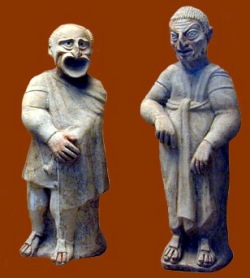
C)
Popular entertainment
- Mime
(the word means a) small plays and b) the actors who pretend): popular
entertainment ( of the
Hellenistic period of the 3 rd century. BC, which later
enters the daily entertainment of the Romans and soon displace
previously atellani popular farce and around 173 B.C. was
established as a permanent feature of celebrations of spring Floralia)
includes short episodes of comic improvisational type with caustic
content on social funny facts of the
time. The themes of mime had yet
to do with everyday life, with spicy and bold descriptions of urban and
rural morals and with mythological themes. Three
were the characteristics of mime who stand it out
from other theatrical events: a) the actors were always professional,
b) do not wear masks and therefore the facial
expression was particularly important and c)
in the
mime
the participation of women was allowed
which women at
the end of the show were
offered as a dessert,
in the form of 'leaving', to the
audience naked.
 All mimes were too much libertarians and were performed
with incredible profanity and vulgarity, with the sole purpose of
entertainment of the crowd. The
mime did not have any scene equipment. They were playing with a naked
face, with heavy make - up, with bare feet (they were
«planipedes»), without the commanding presence of cothurnus
and the stripped
scene was just a simple cloth curtain hung from one end of the scene to
another and there,
in front of it,
the actors played.
All mimes were too much libertarians and were performed
with incredible profanity and vulgarity, with the sole purpose of
entertainment of the crowd. The
mime did not have any scene equipment. They were playing with a naked
face, with heavy make - up, with bare feet (they were
«planipedes»), without the commanding presence of cothurnus
and the stripped
scene was just a simple cloth curtain hung from one end of the scene to
another and there,
in front of it,
the actors played.
- Pantomime
= imitate/mime everything
(the word characterizes the type and the performer).
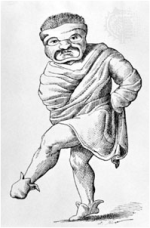 The pantomimist
was characterized “the
legacy of the tragedy”
(opposed to the mime which
was an evolving
form
of comedy). He mangled the tragedy
keeping only the vocal that could give with the mimic.
An actor imitated
silent, with rhythmic movements and gestures only, all the episodes
of a play
creating the images with accompanying dance, telling in a
naturalistic way the story along with the background music. The songs
of a pantomimist
were
a complicated song accompanied by a full orchestra. The dancer
ie the pantomimist
wore
costumes (no fillings and cothurnus) of the tragic theater and masks
called 'masks of silence ",
The pantomimist
was characterized “the
legacy of the tragedy”
(opposed to the mime which
was an evolving
form
of comedy). He mangled the tragedy
keeping only the vocal that could give with the mimic.
An actor imitated
silent, with rhythmic movements and gestures only, all the episodes
of a play
creating the images with accompanying dance, telling in a
naturalistic way the story along with the background music. The songs
of a pantomimist
were
a complicated song accompanied by a full orchestra. The dancer
ie the pantomimist
wore
costumes (no fillings and cothurnus) of the tragic theater and masks
called 'masks of silence ",  firmly on
the face with closed
mouths, as the pantomimists
were dumb. The themes of pantomime
derived from Greek mythology and, therefore tragedies subjects. Pantomime came
to the edge in
the first 3 centuries a. D.
(imperial period). From then onwards second hypocrite was
often used. From
the 4th century. a. D.
also women impersonated, as
their male colleagues, all male and female roles.
firmly on
the face with closed
mouths, as the pantomimists
were dumb. The themes of pantomime
derived from Greek mythology and, therefore tragedies subjects. Pantomime came
to the edge in
the first 3 centuries a. D.
(imperial period). From then onwards second hypocrite was
often used. From
the 4th century. a. D.
also women impersonated, as
their male colleagues, all male and female roles.
D)
artistic forms of theater. The
scholar theater
in Latin literature
includes initially original
translations of Greek tragedies and comedies. A
first contact of the inhabitants of the
Italian peninsula to the Greek theater had already started from
the 5th century BC through
the colonies of southern
Italy and Sicily. Introducer
of the drama in Rome was Livius
Andronicus. 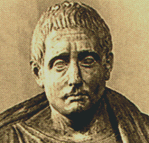 He
translated Greek tragedies and comedies into Latin. In
204 BC the
first works of Livius
Andronicus were played
in
a makeshift tent (as there
were not the subsequent
majestic theater buildings of Roman civilization).
He
translated Greek tragedies and comedies into Latin. In
204 BC the
first works of Livius
Andronicus were played
in
a makeshift tent (as there
were not the subsequent
majestic theater buildings of Roman civilization).
The scholar tradition of the
artistic
Roman
drama (tragedy and comedy) has
the following characteristics:
- There are
common standards for all Latin dramatists, the works of Greek drama,
tragedies and comedies of the classical and Hellenistic periods.
- Predominantly
Greek mythology is
used
for the tragedies
of the Roman drama, whose stories
is a
medley to create a more striking effect (contaminatio).
- In comedy there
is greater freedom and thematic issues are
drawn
from both the Greek myth and Roman daily life.
- To overcome the
difficulties of translating the rich vocabulary and expressions of the
Greek language new words and concepts in Latin are
invented, and several
times Greek
words are romanized.
- The adjustment
in the Latin language was not a simple literal translation of the Greek
model, but adapted to religious beliefs, traditions, customs, habits,
preferences of the Roman public.
- The Roman
tragedy and comedy was a mixed theater with alternating pieces of
prose, the diverbia, with recitation or singing songs to the
accompaniment of flute, the cantica. These latter
unknown in Greek works were either monologues or dialogues with an area
of at least half of the project up to two thirds.
The
artistic Roman theater
includes a) tragedies 1) tragedy and 2) tragedy praetexta) and b)
comedies 1)
comedy palliata and 2) comedy
togata):
A)
1) Tragedy: the Roman
tragedy was depicted
as an alternation of dramatic episodes or scenes, sometimes performed
by a single actor and sometimes
by several persons or dancers. The
performers
of the great tragic monologues,
the forerunners of the later operas had
a highly
processed way of articulation
of speech and shocked the audience. The tragic
characters over the years have become
established roles, in which
certain modes of performance have
been crystallized.
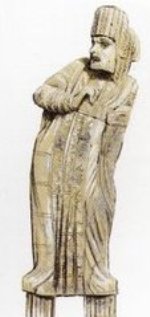
2)
Tragedy praetexta: the tragedy
of this kind flourished in the democratic period of the Roman era (4th
- 1st century BC) and draws her subjects either from myths
associated with the
foundation and the beginnings of Rome, or the oldest Roman history or
even
contemporary events of the era (opposed
to the tragedies that made use of the Greek myths) aiming to portray in a
vivid manner the glorious path of the Roman
army against hostile nations. The actors, as the ancestors of the noble
Romans,
wore the official Roman dress, white robe with purple bars on the lapels
(toga
praetexta). 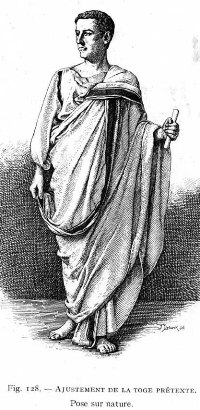 The
main
objective of the
tragedy praetexta was to honor the nobility through public spectacles in which the
Roman people took
place as a spectator. The spectacle was serious, rigorous,
disciplined and aimed at stimulation of the patriotic feelings of the
audience
praising the accomplishments
of great
men, seeking to laud
the
nation of the
Romans and to teach history to younger people in a funny
way. The
works were written in order and in contrast to the classical and
Hellenistic
Greece, where the theater was critical to political action and social
situations, but
in case
of praetexta the power imposes
its
ideas and serves
its
interests. Unique whole project of this
kind
is Octavia
attributed to Seneca.
The
main
objective of the
tragedy praetexta was to honor the nobility through public spectacles in which the
Roman people took
place as a spectator. The spectacle was serious, rigorous,
disciplined and aimed at stimulation of the patriotic feelings of the
audience
praising the accomplishments
of great
men, seeking to laud
the
nation of the
Romans and to teach history to younger people in a funny
way. The
works were written in order and in contrast to the classical and
Hellenistic
Greece, where the theater was critical to political action and social
situations, but
in case
of praetexta the power imposes
its
ideas and serves
its
interests. Unique whole project of this
kind
is Octavia
attributed to Seneca.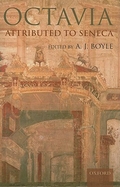
B)
1) Comedy palliata:
hybrid species resulting from the transfer of items of New Comedy in
Latin. The
Romans actors appear on stage
wearing the pallium (= Greek tunic)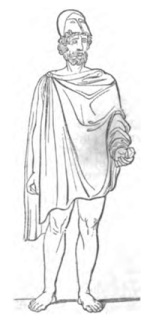 and not the Roman toga. They didn’ t wear
masks and expressed themselves with the grimaces of the face
(a
technique unknown
to
the Greeks actors The
works
of comedy palliata
had
plenty of music and dance. This
was
achieved with a mixed technique
of sung parts
and recited parts. The
sung parts (cantica), unknown to Greek
comedy, were
either
great monologues or dialogues which were
performed
together with dance and song. A
peculiarity also of comedy palliata was the
performance of a role from
two
people, of which one was the actor who imitated and the other the singer
(candor). The
mimetic of the actor should be fully coordinated with the song
accompanying the
singer, so that
truly its content was given.
and not the Roman toga. They didn’ t wear
masks and expressed themselves with the grimaces of the face
(a
technique unknown
to
the Greeks actors The
works
of comedy palliata
had
plenty of music and dance. This
was
achieved with a mixed technique
of sung parts
and recited parts. The
sung parts (cantica), unknown to Greek
comedy, were
either
great monologues or dialogues which were
performed
together with dance and song. A
peculiarity also of comedy palliata was the
performance of a role from
two
people, of which one was the actor who imitated and the other the singer
(candor). The
mimetic of the actor should be fully coordinated with the song
accompanying the
singer, so that
truly its content was given.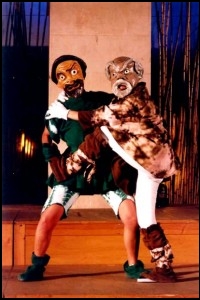 Representative of this type of comedy is Plautus.
Representative of this type of comedy is Plautus.
2)
Comedy togata: a new
kind of comedy where the actors wear only the Roman robe (toga). It is presented in
the last century of the
democratic period (1st cent.
BC) and draws her subjects from the Italian daily life opposed
to palliata
comedy that draws its themes from the New
Comedy. The tragic faces in comedy togata are
less, its duration
was shorter
and its content
more modest
than this of the
comedy palliata.
For
the dialogues colloquial
vocabulary was
usually used. In
comedy togata two types were formed:
a) the comedia tabernaria, which was
played in the taverns for amusement
of the
low-class and b) comedia trabeata, which took its name from trabea , the typical
attire of the riders,
and
dramatized
episodes
from the
lives of riders.
, the typical
attire of the riders,
and
dramatized
episodes
from the
lives of riders.
 roman masks
roman masks
BACK
 who came to mean a
hypocrite - actror, who danced
and sang to the accompaniment of flute.
who came to mean a
hypocrite - actror, who danced
and sang to the accompaniment of flute.  either because they did
not wear shoes or
because they were playing at a
flat orchestra. They
were playing without mask, and they were painting
their faces with chalk and psimythio, an innovative
action at that time
when no hypocrite does not appeared
in the Greek theater without mask.
either because they did
not wear shoes or
because they were playing at a
flat orchestra. They
were playing without mask, and they were painting
their faces with chalk and psimythio, an innovative
action at that time
when no hypocrite does not appeared
in the Greek theater without mask.
 , the old man
(pappus)
, the old man
(pappus) , the eater (bucco)
, the eater (bucco) ,
the hunchback scholar (dossenus)
,
the hunchback scholar (dossenus) . The characters
. The characters  . The themes of atellan
. The themes of atellan


 firmly
firmly  He
translated Greek tragedies and comedies into Latin.
He
translated Greek tragedies and comedies into Latin.


 and not the Roman toga.
and not the Roman toga. Representative of this type of comedy is Plautus.
Representative of this type of comedy is Plautus. , the typical
attire of the rider
, the typical
attire of the rider roman masks
roman masks